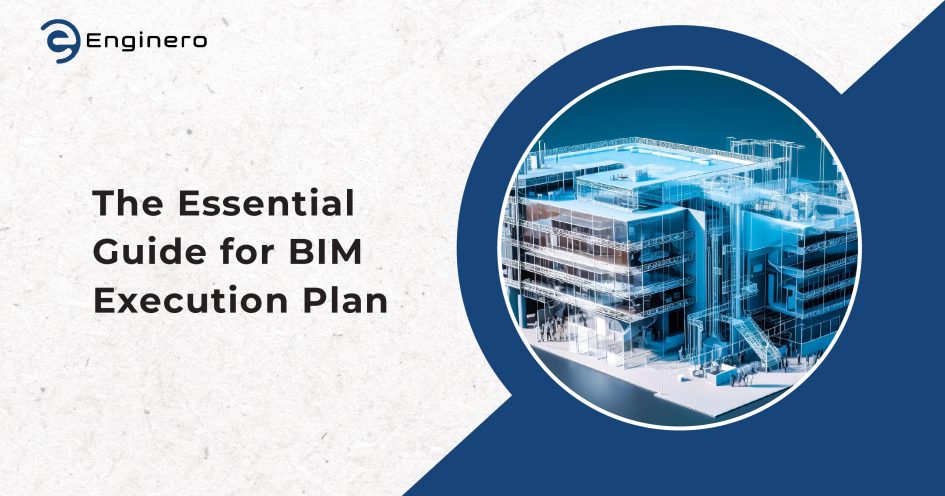Building Information Modelling (BIM) has changed the dimensions of elevating construction projects, unlike primitive ways. Expressing a digital representation of physical construction and allowing for an enhanced lifecycle management is astonishing, and that is what BIM has proposed for the construction industry.
Having a clear plan is an added advantage while indulging in a BIM-based construction project. As it can provoke better ways and enhanced collaboration facilities among the different teams. BIM Execution Plan can be one effective tool here to stimulate better ways of constructing a project with BIM and embracing ideal results.
In this blog, we shall discuss the amenities of having one ideal BEP and ways of developing such a significant BIM Execution Plan.
BIM Execution Plan (BEP)
The term ‘execution plan’ itself indicates the aspect of BEP. The BEP is a living document used in planning and during a project, which can be used as a contract deliverable, effective project management tool to ensure that all parties are clearly aware of the opportunities and responsibilities associated with the incorporation of BIM into the project workflow
Using BEP for a construction project will enhance better ways for the teams to collaborate on the plans and obtain a clear vision of the project, and then follow the process to avoid any misconceptions and issues with the project.
Since the BEP expresses the way in which the project is about to be executed, the project teams can build better strategies to collaborate and communicate with peers and therefore follow the plan and intervene with changes if required at specific times.
The Need for BIM Execution Plan (BEP)
The never fading AEC industry has reached another major milestone in recent years with BIM where each piece of information is captured and stored for better elevation and performance. Since BIM has engulfed the information and catered as a single source of truth, having a credible BEP can expand more options for better and streamlined construction and services.
BEP outlines how BIM will be implemented on a specific project, ensuring that all stakeholders are aligned and that the project objectives are met efficiently.
The AEC project will have multiple teams and when this BEP is proposed to the teams, each team will acknowledge their role and responsibilities with the construction project. Here, the large-scale project can go unhindered with the plan and obtain ideal results with proactive collaboration.
The BEP is meant to determine not only the biggest project objectives, but which ones can go through BIM first and the end. The project goals, slated BIM uses (like collision detection, cost estimation, and energy analysis), and performance parameters are inclusive in this.
- To start with, to say that every single stakeholder, from the designers to contractors, grasps and agrees with the BIM objectives and how they will be gauged, is ensured.
- The BEP prescribes clear tasks and proper allotment of work among the project stakeholders of the project, thus preventing confusion and rework.
- Data Sharing articulates how data will be shared and handled, including file formats, naming conventions, and protocols for model integration; thus, it is one of the means of collaboration.
- All parties will clearly understand and communicate the strategic goals for implementing BIM on the project. Organizations will understand their roles and responsibilities.
- The team can design an execution process that is well-suited for each team member’s business practices and typical organizational workflows. The plan will outline additional resources, training, or other competencies necessary to successfully implement BIM for the intended uses.
- The plan will provide a benchmark for describing the process to future participants who join the project. The purchasing sectors can define contract language to ensure all project participants fulfill their obligations.
- The baseline plan will provide a goal for measuring progress throughout the project.
What makes a complete BIM Execution Plan (BEP)
A BIM Execution Plan will have specific attributes that support the whole construction mechanism in an effective way. Here are some sections that a BEP will prominently have.
- Strategic plans for the project, BIM scopes and pre-defined project deliverables.
- Project timeline and list of approaches planned for it.
- BIM project goals and objectives
- Quality/quantity control procedures and associated data.
- Extensive project information, including intra and inter-contact information.
- Comprehensive procedure document.
- Summary description of the BEP document, developed to briefly communicate the contents and status of the BEP.
- Description of the format used for storing the BEP data elements.
- Table of information regarding the quality control activities on the project.
- Collaboration with different stakeholders.
Fortunes for construction projects with an effective BEP
The AEC industry can have many benefits with initiating and following a BEP for their project. Here we list the impressive attributes that the plan propels to enhance diverse projects.
Streamlined communication
Early plans can effectively stimulate the teams to have enough to discuss and communicate the construction process. With BEP, the teams can communicate the plan, responsibilities and build better workflow.
Standard collaboration
The vast projects with BIM as base can make use of the BEP to bring effective collaboration to the construction project. The project holders or the teams can be scattered all around the globe, and this BEP can be one single source of truth for the teams and avoid them to stuck at any time with misconceptions.
Time conserving
Spending more time on discussions, understanding the responsibilities and roles, and communicating with project teams can be eliminated or reduced with the effective BIM Execution Plan. Since the plan discloses all the above details with utmost precision, this can take up less time and can provoke the team to progress streamlined without any issues.
How to develop an effective BIM Execution Plan
Upon speaking about the eminence of BEP for an AEC project, how to develop the plan can be a question. However, having revealed the fragments of the plan, we will here list the aspects to follow to develop the ideal BEP for vital projects.
- Define the purpose of using BIM for the construction projects: using it for clash detection, coordination, enhanced design visualization and more. Give importance to the goals for BIM to catalyze the project with ideal targets.
- Display the standards that are about to be used in the project, including the BIM standards, model conversion methods, file formats and more.
- Create a hierarchy for the project teams and build a better stage for effective communication. Clearly mention the roles and responsibilities for the teams to manage the BIM models.
- Make a module to explain how the models will be coordinated among teams and showcase the clear communication structure and channels where the teams can be engaged for collaborating on BIM-related information.
- Fragment the quality standards for the models and set a benchmark for model accuracy. BEPs can be updated as per the project requirement and expose a clear process that will be followed during updating the BEP for the project.
Closing Thoughts
BIM projects are creating more impressions in the AEC industry, claiming more accuracy and precision at every stage of the project. This includes post-project completion with effective lifecycle management.
Having an effective BEP can create more impact effortlessly for the project teams. Having mentioned the eminence of the BEP and the scopes it can offer, it is never late for you to create or get the ideal BIM Execution Plan for your project and streamline the effective construction process.


Leave a Reply